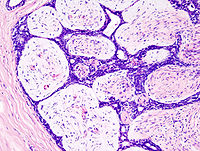
Photo from wikipedia
RATIONALE AND OBJECTIVES To preliminarily asses if Contrast Enhanced Digital Mammography (CEDM) can accurately reduce biopsy rates for soft tissue BI-RADS 4A or 4B lesions. MATERIALS AND METHODS Eight radiologists… Click to show full abstract
RATIONALE AND OBJECTIVES To preliminarily asses if Contrast Enhanced Digital Mammography (CEDM) can accurately reduce biopsy rates for soft tissue BI-RADS 4A or 4B lesions. MATERIALS AND METHODS Eight radiologists retrospectively and independently reviewed 60 lesions in 54 consenting patients who underwent CEDM under Health Insurance Portability and Accountability Act compliant institutional review board-approved protocols. Readers provided Breast Imaging Reporting & Data System ratings sequentially for digital mammography/digital breast tomosynthesis (DM/DBT), then with United States, then with CEDM for each lesion. Area under the curve (AUC), true positive rates and false positive rates, positive predictive values and negative predictive values were calculated. Statistical analysis accounting for correlation between lesion-examinations and between-reader variability was performed using OR/DBM (for SAS v.3.0), generalized linear mixed model for binary data (proc glimmix, SAS v.9.4, SAS Institute, Cary North Carolina), and bootstrap. RESULTS The cohort included 49 benign, two high-risk and nine cancerous lesions in 54 women aged 34-74 (average 50) years. Reader-averaged AUC for CEDM was significantly higher than DM/DBT alone (0.85 versus 0.66, p < 0.001) or with US (0.85 versus 0.75, p = 0.001). CEDM increased true positive rates from 0.74 under DB/DBT, and 0.89 with US, to 0.90 with CEDM, (p = 0.019 DM/DBT versus CEDM, p = 0.78 DM/DBT + US versus CEDM) and decreased false positive rates from 0.47 using DM/DBT and 0.61 with US to 0.39 with CEDM (p = 0.017 DM/DBT versus CEDM, p = 0.001 DM/DBT+ US versus CEDM). For an expected cancer rate of 10%, CEDM positive predictive values was 20.5% (95% CI: 16%-27%) and negative predictive values 98.3% (95% CI: 96%-100%). CONCLUSION Addition of CEDM for evaluation of low-moderate suspicion soft tissue breast lesions can substantially reduce biopsy of benign lesions without compromising cancer detection.
Journal Title: Academic radiology
Year Published: 2019
Link to full text (if available)
Share on Social Media: Sign Up to like & get
recommendations!